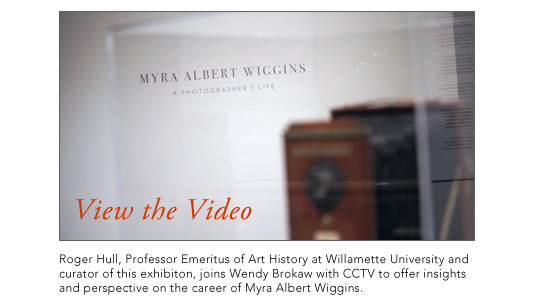"Myra Albert Wiggins: A Photographer's Life"
February 14 – April 26, 2015
Study Gallery and Print Study Center
Myra Albert Wiggins (1869-1956) was a Salem photographer and early member of Alfred Stieglitz’s Photo-Secessionist Group. At the turn of the last century, Wiggins was considered one of the foremost women photographers in America. A major exhibition of her work will open February 14 and continue through April 26, 2015, in the Study Gallery and Print Study Center.
Born and raised in Salem, Oregon, Wiggins was a painter, poet and singer, as well as an instructor, essayist and speaker on art topics. But it was as a photographer that she established herself as an internationally recognized artist. From the late 1890s until 1910, her photographs were exhibited throughout the United States, as well as Paris, Vienna and London.
Wiggins attended Willamette University and Mills College, and in 1891 she began three years of study at the Art Students League in New York, where she received instruction from leading American painters William Merritt Chase, George DeForest Brush and Kenyon Cox. Her photographic interests prompted her to join the Society of Amateur Photographers of New York where she met and impressed a fellow member, Alfred Stieglitz, who was to become the most famous and influential photographer of the era.
She returned to Salem and in 1894 she married Frederick Wiggins. During the next decade and half, Wiggins continued to gain recognition. She was especially known for her touching and award-winning pictorial Dutch genre photographs that focused on women and children. Her work won numerous prizes, including cash awards and even a trip to Paris in 1900.
When Stieglitz established the famed and exclusive Photo-Secession in 1903, he selected Wiggins as an associate member. The group promoted the controversial and hotly debated idea that photography should be acknowledged as a legitimate form of fine art.
In 1907 Wiggins moved with her husband and daughter, Mildred (Benz), to Toppenish, Wash. and to Seattle in 1932. Following 1910, Wiggins shifted the bulk of her time and effort to painting. Her greatest success and legacy remains to be her work as a photographer in a pivotal time that defined the way the world viewed photography.
Two lectures accompany the exhibition. On Feb. 15 Carole Glauber, a teacher, curator and author of "Myra Wiggins: The Witch of Kodakery," will discuss the life and career of the photographer. On March 15 Roger Hull will explore the art historical and photographic references found in Wiggins’s work. Both lectures are free and open to the public and will be held in the Roger Hull Lecture Hall at the Hallie Ford Museum of Art beginning at 2 p.m. The exhibition also includes a complimentary brochure by Hull.
This exhibition has been organized by Professor Emeritus of Art History and Senior Faculty Curator, Roger Hull, and includes photographs and ephemera drawn from the museum and the Pacific Northwest Artists Archives at Willamette University.
Financial support for the exhibition has been provided by grants from the City of Salem’s Transient Occupancy Tax funds and the Oregon Arts Commission.
EXHIBITION BROCHURE
A complimentary 16-page scholarly brochure with an essay by Roger Hull accompanies the exhibition.

EXHIBITION RELATED EVENTS
Lecture
A Life in Pictures: Myra Albert Wiggins
Carole Glauber
Sunday, February 15, 2015 at 2 p.m.
Roger Hull Lecture Hall, Hallie Ford Museum of Art
Admission is complimentary
Carole Glauber, a teacher, curator and author of Myra Wiggins: The Witch of Kodakery, will discuss the life and career of the photographer.
Lecture
Art References, Art Echoes in the Photography of Myra Albert Wiggins
Roger Hull
Sunday, March 15, 2015 at 2 p.m.
Roger Hull Lecture Hall, Hallie Ford Museum of Art
Admission is complimentary
Roger Hull will explore the art historical and photographic references found in Wiggins’s work.


![Myra Albert Wiggins, [italics]Nymphaea[/italics] (detail), 1908](myra-wiggins-gallery/wiggins.jpg)